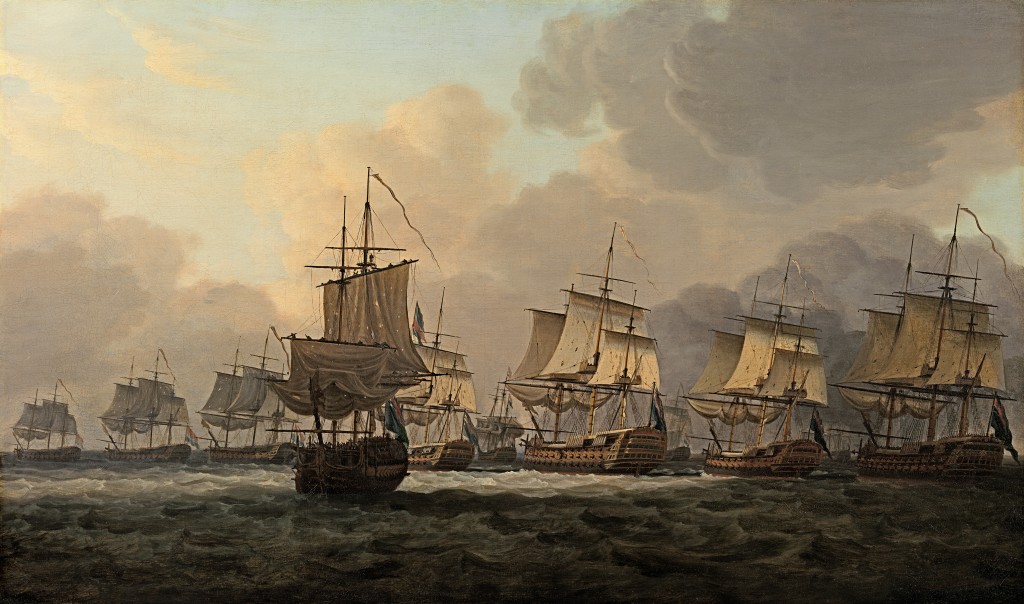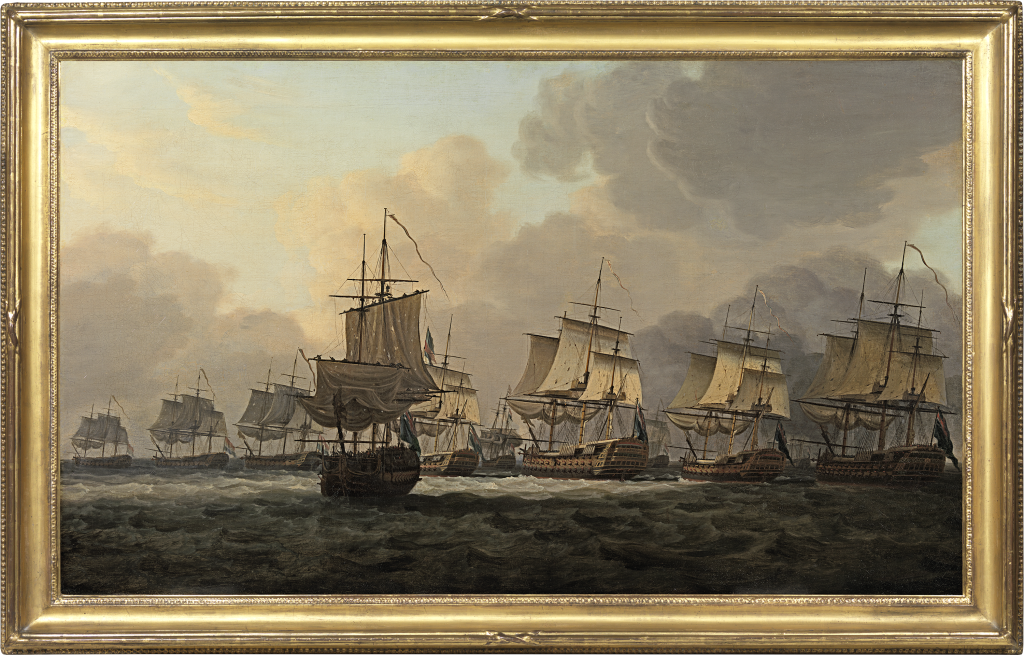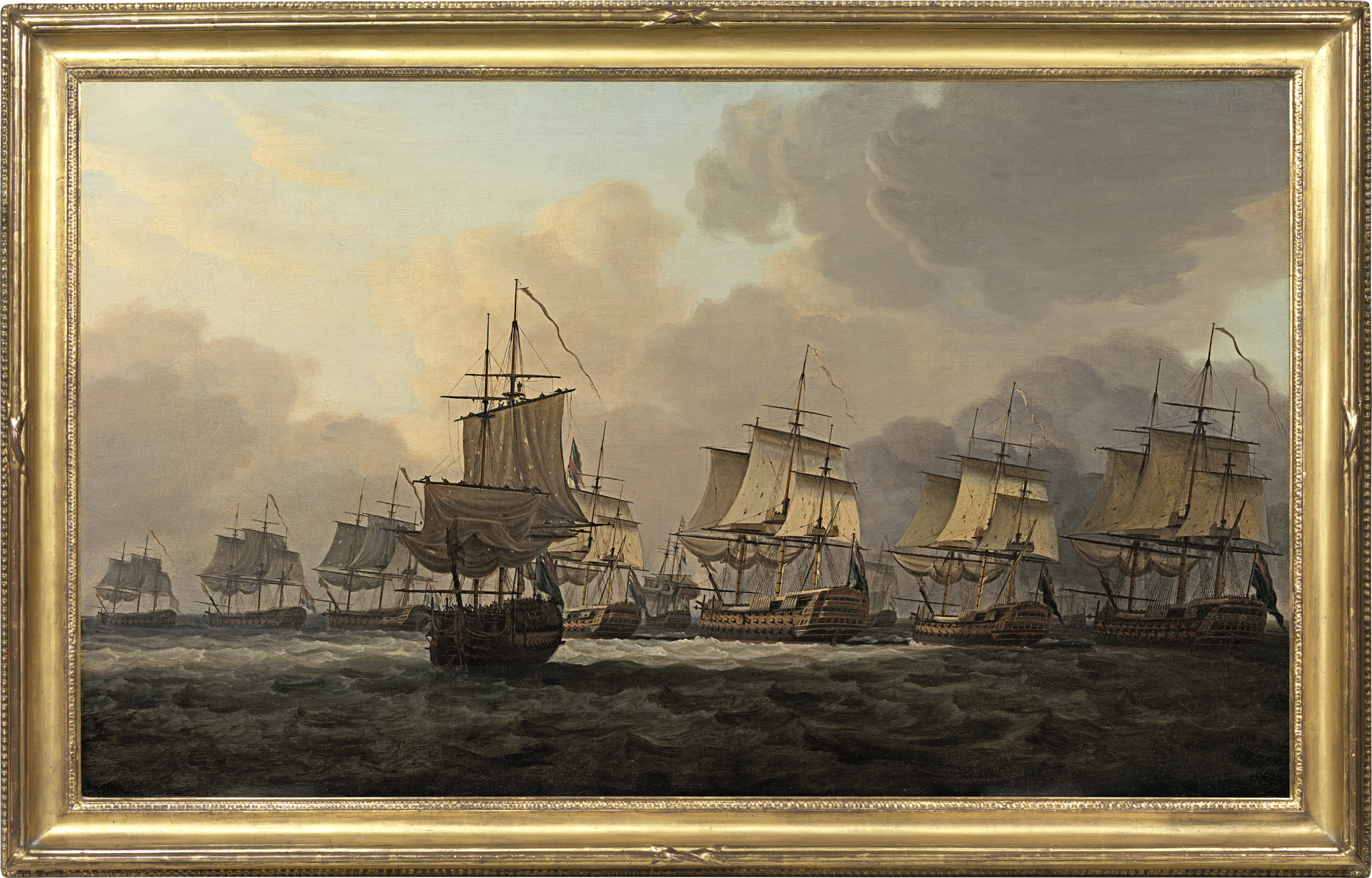DOMINIC SERRES
Auch, Gascony 1719 - 1793 London
Ref: CA 230
Vice-Admiral Hyde Parker’s action with the Dutch Fleet on the Dogger Bank, 5th August 1781
Signed and dated lower right: D. Serres. 1781
Oil on canvas: 26 3/8 x 44 ¼ in / 67 x 112.4 cm
Frame size: 31 ½ x 49 ½ in / 80 x 125.7 cm
Engraved:
By Robert Pollard, published by Robert Wilkinson and Robert Pollard, 1st May 1782
Provenance:
Jonathan Janson, UK
Exhibited:
Munich, Haus der Kunst, British Council exhibition, Zwei Jahrhunderte englische Malerei. Britische Kunst und Europa. 1680 bis 1880, 1979, section 1, no.11 (lent by Mr J Janson)
Literature:
Alan Russett, Dominic Serres RA, 1719-1793, War Artist to the Navy, Woodbridge 2001, p.113
Unusually for an artist who depicted British naval actions, Dominic Serres was French. From the Gascon gentry, he ran away to sea to avoid the fate of becoming a priest. Captured during the War of the Austrian Succession and brought to London, he made a career as a marine painter, helped both by personal charm and his knowledge of seamanship.
Serres is best known for his depictions of naval actions of the Seven Years’ War (1756-63) and the War of American Independence (1775-83). The Dogger Bank action shown in this painting occurred in the latter conflict. France, hoping to best her British rival, allied with the American rebels, as did the Dutch, hoping to regain some of her maritime supremacy.
Serres’s painting shows the only engagement between Dutch and British squadrons in the American War, on the Dogger Bank between Britain and Holland. In a steely North Sea dawn, boiling with dark clouds, Vice-Admiral of the Blue Hyde Parker (1714-1782/3), escorting a convoy of 200 merchantmen, fell in with Rear-Admiral Johan Arnold Zoutman’s (1724-1793) squadron sailing north with Dutch merchant vessels. The squadrons were evenly matched. Parker had seven ships-of-the-line, four frigates and an armed cutter. Zoutman had seven ships-of-the-line, five frigates and an armed cutter[1]. The signal for battle was hoisted at 7.56am; the Royal Navy had the weather-gage. Serres shows the beginning of the battle with Parker’s 74-gun flagship Fortitude in the centre of the line, bearing down towards Zoutman’s flagship Admiral de Ruijter, 68. The decks of the warships are crammed with sailors, in blue, with the red jackets of the marines visible in the stern.
At 8am the signal for close action was hoisted. The battle raged until 11.35am. The fierceness of the action is apparent from the state of the sails, peppered with canon shot. In fact it was a contest in which both sides also fired low, sending deadly splinters across gun decks and dismounting guns. The Dutch convoy ran eastwards for the safety of the Texel estuary while the squadrons fought grimly on to a stalemate. Neither squadron had started in perfect order; Parker’s ‘were chiefly very old ships, dragged out from Rotten Row to meet the pressing emergency’[2], while ‘the Dutch vessels, after a long peace, were not much better than their antagonists’[3]. When the Dutch squadron bore away for the Texel, Parker’s ships were in no condition to follow them. Extreme bravery was shown on both sides and casualties were high. The British had 104 killed and 339 wounded, the Dutch 142 killed, 403 wounded. As William Laird Clowes comments in his history of the Royal Navy, ‘This was a most satisfactory exhibition of valour, and a most unsatisfactory battle; magnificent, but not war’[4].
Speed was of the essence to a marine painter. Serres completed this painting in 1781, not long after the battle; an engraving of it was published the following year. Avidly tracking the exploits of the Royal Navy, the public clamoured for representations of the latest actions. Serres would have relied on newspaper accounts, official log books, word of mouth from those present and his own acute knowledge of naval warfare. This painting evokes the drama of the heat of battle, enhanced by the bold shadows on the water, the spiralling clouds and the fitful light on sails and guns, as the sailors of two great maritime nations tussle for supremacy.
The following year, Serres completed a larger version of this composition for the Parker family, which still hangs at their Suffolk seat, Melford Hall, Long Melford[5].
Admiral Sir Hyde Parker, 5th Bt., was part of a Royal Naval dynasty whose adventures read like a Patrick O’Brian novel. Unusually, he started his career in the merchant service and entered the Royal Navy at the ripe age of twenty-four, beginning as an able seaman instead of the midshipman route taken by aspiring RN officers. In 1756 he negotiated the release of European slaves with the ruler of Morocco. In 1760 he sailed for the East Indies. Commanding the Panther, Parker intercepted the Spanish treasure ship Santissima Trinidad on her voyage from Manila to Acapulco. His Captain’s prize money was some £30,000, the equivalent of over £7 million today. On 17th April 1780 Parker was Admiral Rodney’s second-in-command at the battle with the French off Martinique; he was censured by Rodney for failing to press his advantage and pursue the fleeing enemy. The following year Parker was appointed to command a squadron in the North Sea, escorting merchant ships trading with the Baltic. After the battle of Dogger Bank, George III went down to the Nore to meet him. He was told by the Admiral, who was furious at the government complacency which had given him old, badly prepared ships, that ‘I wish your Majesty better ships and younger officers; for myself, I am now too old for service’[6].
After the death of his elder brother in July 1782, Hyde Parker succeeded to the Baronetcy and was appointed Commander-in-Chief in the East Indies. He sailed in the Cato, which disappeared after leaving Rio de Janeiro on 12th December and was never heard of again.
Sir Hyde Parker’s son and namesake was also present at the Dogger Bank action as Captain of the frigate Latona. As the second Admiral Sir Hyde Parker (1739-1807), he became notorious as Nelson’s commander at the 1801 Battle of Copenhagen, who gave the signal to disengage. As the (probably apocryphal) story goes, Nelson put his telescope to his blind eye, remarking: ‘I have only one eye. A man has the right to be blind sometimes; I really do not see the signal’. Ignoring Parker, he went on to victory.
DOMINIC SERRES THE ELDER
Auch, Gascony 1719 – 1793 London
Dominic Serres, although French, was the most successful London-domiciled painter of naval actions of the Seven Years’ War (1756-63) and the War of American Independence (1775-83). Serres came from the Gascon gentry; his uncle was Archbishop of Rheims and in his Gentleman’s Magazine obituary he is referred to as Comte Serres. He was educated at the English Benedictine school at Douai, which explains his ease among the English.
Intended by his family for the priesthood, Serres ran away to sea. He was captured and brought to England, possibly late in the War of the Austrian Succession (1741-48). Serres’s charm, education and practical knowledge of seamanship proved most useful in gaining patrons when he decided to make his living as a painter. His early works, influenced by Charles Brooking, are luminous calms with a romantic air; later he took a more realistic approach to his subjects, which make his paintings valuable historical documents.
Serres was a founder member of the Royal Academy in 1768 and its librarian in the last year of his life; from 1779 he was Marine Painter to George III. He exhibited at the Free Society exhibitions and became a member of the Incorporated Society of Artists in 1765. Dominic Serres died in London in 1793. His two sons, Dominic the Younger (c.1761/2-c.1804) and John Thomas (1759-1825) also became marine painters.
The work of Dominic Serres is represented in the US Naval Academy Museum, Annapolis; the Art Gallery of Nova Scotia, Halifax; the Tate Gallery, London; the Fitzwilliam Museum, Cambridge; the National Maritime Museum, Greenwich and the National Gallery, Dublin.
[1] William Laird Clowes, The Royal Navy: a History from the Earliest Times to 1900, vol. 3, pp.504-508.
[2] Clowes, op. cit., p.505.
[3] Ibid., p.506.
[4] Ibid., p.508.
[5] 36 x 62 in / 91 x 157 cm. Alan Russett, Dominic Serres RA, 1719-1793, War Artist to the Navy, Woodbridge 2001, p.119.
[6] Quoted in Clowes, p.508.








